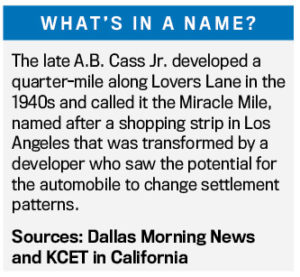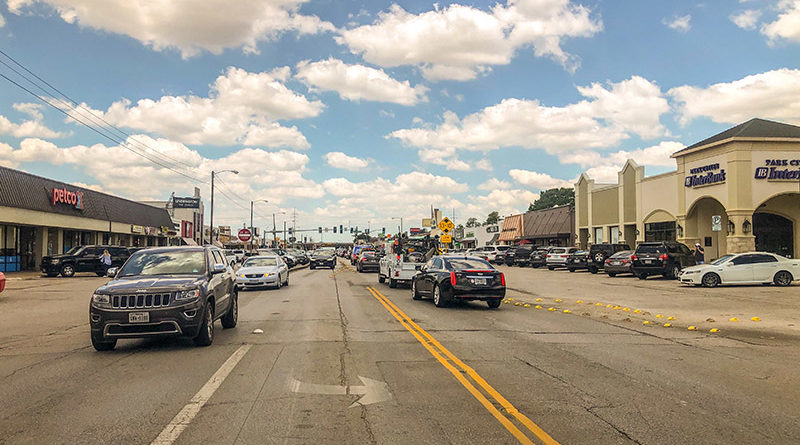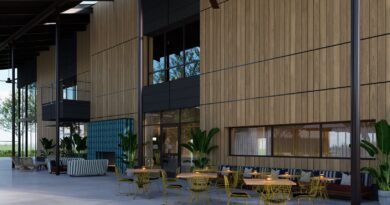The Not-So-Miracle Mile
Remember the childhood story where Goldilocks enters the house of the three bears, eats their porridge, and lays in their beds?
(ABOVE – IF YOU GO: University Park City Council members are expected to consider final design options to upgrade the Miracle Mile on miracle Mile at their Aug. 6 meeting. Photo by Bianca R. Montes)

Young Goldilocks learns about the bears’ individual preferences, determining that one’s was always too much on one extreme (too hot, too hard), one’s was too much of the other extreme (too cold, too soft), and one’s was just right.
Consultants hired by the city of University Park used that concept, called the Goldilocks principle, to steer the design process for revamping a stretch of Lovers Lane between Douglas Avenue and Lomo Alto Drive. The idea: Solutions are found within certain margins, as opposed to the extremes.
In November 2018, council members approved a nearly $470,000 contract with Huitt-Zollars to create a master plan for portions of Preston Road, Hillcrest Avenue, and the Miracle Mile along Lovers Lane.
Public Works director Jacob Speer said the proposed $7.2 million Miracle Mile renovation would address 60-something-year-old deteriorated pipes as well as the pavement – all the way to the base – which is crumbling apart.
“You can’t fix that,” Speer said. “The question became, if we are going to cause disruption, what else should be done at the same time to gain additional benefits.”
Parking, pedestrian flow, and traffic flow were all identified as crucial areas to address after the city and consultants analyzed traffic and parking patterns and met with Miracle Mile merchants, owners, neighbors, and Highland Park Independent School District representatives.
Those issues were addressed in three design concepts: a parking extreme, an access extreme, and the “just right” compromise.
Adding significantly more parking, the consultants told the city, would come at a high cost: reduced access and creating cramped quarters (seen in option A).
To provide more pedestrian access, including designated fire lanes on either side of the shopping center, Miracle Mile would also come at a cost: less parking (seen in option B).
“Parking is the most evident issue; it’s literally staring you in the face,” Speer said. “All you see is parked cars. It’s the first and last thing you experience.
“Part of the problem is that people do not view it as a shopping center, but instead two different areas (eastbound and westbound). If it felt more like a shopping center where people could cross from one side to the other, you’ve doubled your parking, even if nothing changes.”
Christie Leinart, who has been shopping on Lovers Lane for more than a decade, said she sometimes has to turn around due to a lack of parking.
“If (the city) is going to do anything here, they should add more parking,” she said.
Other shoppers disagreed, saying they come to the Miracle Mile for “the vibe.”
Merchants remain skeptical about the project. Rena Kim, of Yummy Donuts, questioned how small business owners would survive months of construction and whether additional parking would actually improve the situation. “Everyone wants more parking, but it’s not worth the time it would take for construction to finish,” she said.
During a work session early July, most council members favored Option C, a compromise of the two extreme offerings, but wanted the consultants to address some of the access issues.
Option A: The Parking Option
If there was a place to put a parking spot the designers have found it and used it in option A. By shrinking Lovers Lane a foot in each direction and extending parking nearly to the tollway; this option increases parking from 260 spots to 344. The option also increases ADA parking spots from eight to 17. What is lost with option A is access points for through traffic into surrounding neighborhoods; for example, there will be no travel lane access for Northbound Lomo Alto Drive, resulting in heavier turning movements at Armstrong Parkway. Turning lanes also will be removed at all access points, and the actual turn space will become extremely narrow.

A1: The parking aisle and first entrance would be stretched toward the Dallas North Tollway, starting a block before the Shell Station at Lomo Alto Drive and Lovers Lane. A2: Turn lanes would be removed from Lovers Lane at Lomo Alto Drive and Armstrong Parkway. A three-way signal would replace current lighting at Armstrong Parkway. A3: * All three options would create mid-block pedestrian crossings at Lomo Alto Drive and Armstrong Parkway. (all graphics work is done by Melanie Thornton)
Option B: The Access Option
If you’re a fan of elbow room, then this option will likely be your favorite – but you might be alone seeing as most stakeholders disliked it. This option would keep Lovers Lane at 12-feet-wide in both directions; offer a landscaped median, create more room between parked cars and traveling cars, and make room for fire lane access on both the eastbound and westbound drive aisles. Currently, emergency vehicles must close off Lovers Lane when called. However, all of that space comes at a cost: parking. While additional parking would be made on the north side, available spots would decrease 17 spaces.

B1: A reduction in parking would allow for designated fire lanes on both the eastbound and westbound parking aisle. B2: A landscaped median would stretch from the Dallas North Tollway to Armstrong Parkway.
Option C: The Mix of Options
Option C is the “not too hot, not too cold” design. It provides more openings and access than Option A and more parking than Option B. It is the closest to what is currently seen on Lovers Lane and increases parking spots from 260 to 285, 13 of which would be ADA compliant. This option shrinks Lovers Lane a foot in each direction, offers broader parking in the drive aisle and wider sidewalks and a buffer area between parking and the travel lanes. But, there is no room for a designated fire lane.

C1: All parking in the drive aisles would be horizontal, creating a broader path for drivers, wider sidewalks, and a buffer area between parking and travel lanes. C2: *All three options would create a continuous pedestrian path between the Dallas North Tollway and Douglas Avenue.
The council is expected to review reconfigured designs at their next meeting and would have to sign off on a design before September to submit a proposal to Dallas County’s Capital Improvement Fund, which if approved could help share costs. Though, Speer added that the project is not contingent on being awarded any money from the county.
Parking Study
A parking study was conducted from March 4 to 11 on Lovers Lane. In 15 minute intervals, researchers looked at parking spots from 10 a.m. to 1 p.m. and from 3:30 to 6:30 p.m. Here are a few takeaways from the results.
• Regardless of the time of day, people typically parked at Miracle Mile for 30 minutes or less. About 20% are parked up to an hour and 10% for up to an hour and a half. For weekdays and weekends, there is a noticeable 10% of vehicles that were there for the duration of the study, three hours and four hours respectively.
• The parking demand is highest around noon on weekdays and weekends and at 4:30 p.m. on weekdays. Many zones reached 100% occupancy. It was noted that at least 67% of parking spaces were occupied at any time of day. Occupancy increased during lunchtime to a maximum total occupancy of 85%. On average, parking spaces in the Miracle Mile are occupied 78% of the time.
• Parking enforcement is not consistent.
• A 10-question patron parking study conducted during the same time showed that 71% of the 37 people surveyed said they sometimes or usually find parking and 80% stated it takes them five minutes or more to find a parking space.
• 41% of those surveyed said they want more parking spaces, and 35% said they wanted designated spots for businesses.
Keyuri Parab and Jaxx Artz contributed to this story.









